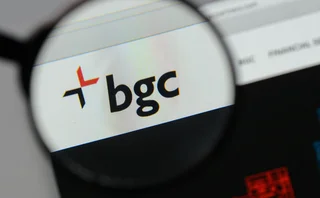December 2011: Time to Stop Chasing Rainbows

High-frequency trading seems to be everywhere right now. This month’s issue of Waters, the largest we’ve ever produced, is a case in point: We have the writeup of an HFT webcast we hosted recently, sponsored by Intel and Sybase; Sitanta Ni Mathghamhna’s feature delves into the nuts and bolts of measuring latency; and Rob Daly’s Japan feature and Jake Thomses’ Brazilian feature focus on what has become a crucial source of revenue for buy-side and sell-side firms in mature and, increasingly, emerging markets.
During the course of the webcast, Christian Sommer, director of capital markets marketing at Intel, explained that client demand is continuing to fuel the incessant drive toward shrinking latency, a trend that has yielded some startling developments over the last number of years. “We have seen a two-thousand-fold drop in average core-trading latency in the last three years, and I think the move to measure trading latency in picoseconds is nearing,” Sommer asserted. “We’re not there yet, but it’s in the not-too-distant future.”
For those of you not familiar with a picosecond, it’s one trillionth of a second, which, according to Wikipedia, can be articulated this way: A picosecond is to one second as one second is to 31,700 years. We are nowhere near that kind of territory at the moment, and certain commentators contend that it’s unlikely that as things stand, the financial services industry will ever need that kind of latency. Neil McGovern, senior director of strategy, financial services, at Sybase, didn’t contradict Sommer’s assessment, but rather chose to focus on the practicality of such infinitesimally small measures of time. “Light travels 30 centimeters in one nanosecond,” McGovern said. “So if light can go only a few centimeters in a picosecond, how much faster are you going to get? What are you going to be able to do in such a short space of time?”
McGovern’s point is difficult to counter, which got me thinking back to my teaching days and the conversations I allowed myself to get sidetracked into by some of my senior pupils. We often discussed the notions of contentment and happiness, and, while Deepak Chopra will no-doubt scoff at the banality of my advice, we most often concluded that we’re never likely to be content until such time as we acknowledge that what we have is enough and that we do not want or need more. I’ve argued along these lines before in this column, specifically with reference to reducing latency as a means of super-charging HFT environments, and this month is no different: Firms need to decide for themselves how fast is fast enough, because the rainbow-chasing scenario that many players have inadvertently become slaves to, is unsustainable.
Only users who have a paid subscription or are part of a corporate subscription are able to print or copy content.
To access these options, along with all other subscription benefits, please contact info@waterstechnology.com or view our subscription options here: http://subscriptions.waterstechnology.com/subscribe
You are currently unable to print this content. Please contact info@waterstechnology.com to find out more.
You are currently unable to copy this content. Please contact info@waterstechnology.com to find out more.
Copyright Infopro Digital Limited. All rights reserved.
You may share this content using our article tools. Printing this content is for the sole use of the Authorised User (named subscriber), as outlined in our terms and conditions - https://www.infopro-insight.com/terms-conditions/insight-subscriptions/
If you would like to purchase additional rights please email info@waterstechnology.com
Copyright Infopro Digital Limited. All rights reserved.
You may share this content using our article tools. Copying this content is for the sole use of the Authorised User (named subscriber), as outlined in our terms and conditions - https://www.infopro-insight.com/terms-conditions/insight-subscriptions/
If you would like to purchase additional rights please email info@waterstechnology.com
More on Trading Tech
Nasdaq to market new options strike listing tech to other exchanges
The exchange operator is experimenting with emerging technologies to determine which options strike prices belong in a crowded market, with hopes to sell the tech to its peers.
The IMD Wrap: Talk about ‘live’ data, NAFIS 2024 is here
This year’s North American Financial Information Summit takes place this week, with an expanded agenda. Max highlights some of the must-attend sessions and new topics. But first, a history lesson...
MarketAxess builds strategy around X-Pro
MarketAxess profits were down in Q1, but revenues were up and automation volume hit a record $94 billion.
Canada’s triparty repo launch aims to fill C$60bn void
Test trades on TMX/Clearstream platform represent “quantum leap” for creaking funding markets.
People Moves: NorQuant, Tradition, Duco, HKEx, SimCorp, Hazeltree, Xceptor, Broadridge, and more
A look at the past month’s people moves in the capital markets technology and data space.
Bank-led consortium takes aim at position reporting
Five banks, including Barclays, BNP Paribas, Goldman Sachs and HSBC, have joined forces to mitigate interpretation and implementation errors in position reporting disclosures.
This Week: BBH, AllianceBernstein add data solutions, Deutsche Börse-Nodal Exchange, and more
A summary of some of the latest financial technology news.
Consortium backs BGC’s effort to challenge CME
Banks and market makers—including BofA, Citi, Goldman, Jump and Tower—will have a 26% stake in FMX.
Most read
- Waters Wavelength Podcast: S&P’s CTO on AI, data, and the future of datacenters
- Waters Wavelength Podcast: Bloomberg’s Tony McManus
- IMD & IRD Awards 2024: All the winners








